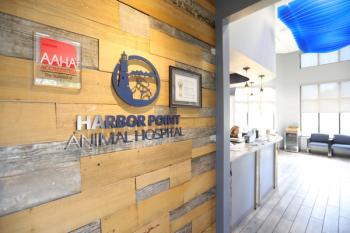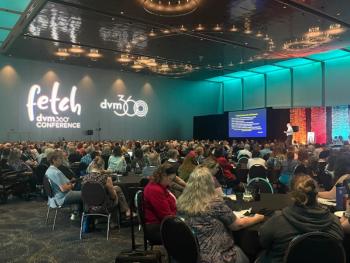
DeHaven selected to lead AVMA
Schaumburg, Ill. - The American Veterinary Medical Association named Dr. Ron DeHaven as its new executive vice president to help lead the organization and replace retiring Dr. Bruce Little, who has held the position for 11 years.
SCHAUMBURG, ILL. — The American Veterinary Medical Association named Dr. Ron DeHaven as its new executive vice president to help lead the organization and replace retiring Dr. Bruce Little, who has held the position for 11 years.
Bringing government and agriculture experience to an organization dominated by small-animal practitioners, DeHaven will work with AVMA's Executive Board, House of Delegates and executive management team to develop long-range goals, strategies and policies. Currently serving as administrator of the USDA's Animal Plant Health Inspection Service (APHIS), DeHaven will succeed Little, the AVMA's longest serving officer, who is retiring at year's end.
While no official start date has been confirmed, DeHaven is expected to take the position in late summer. Until then, he is reserving comment about his agenda, goals and thoughts on the position, says Andrea McNally, APHIS spokesperson, despite requests from DVM Newsmagazine.
The six-person search committee considered candidates for more than six months before choosing DeHaven, who fit the profile created by surveying members, industry representatives, AVMA and veterinary-school leaders, says Robert "Bud" Hertzog, DVM, 2005-2006 AVMA executive board chair and search committee member.
Search committee members were Drs. Larry Kornegay, chair; House of Delegates representative Michael Whitehair; and Hertzog, James Brandt and Deborah Kochevar as the at-large representatives.
"We did an extensive survey of almost everybody connected with AVMA and determined we were looking for someone who is a dynamic leader with a good understanding of the big picture of veterinary medicine and someone who can lead us into the next century. We felt Dr. DeHaven had those qualities," Hertzog says.
Declining to reveal the total number of applicants or name other frontrunners, Hertzog did say the committee reviewed a number of exceptional candidates.
The executive vice president position is tasked with guiding overall AVMA operations, implementing association policies, motivating and driving the 138 AVMA employees that make up the management teams and general staff and building and monitoring relationships with allied organizations, all while helping to broaden the scope of the veterinary profession and fulfill AVMA obligations, according to the association.
The AVMA currently has 14 allied organizations in the House of Delegates, including the American Animal Hospital Association and National Association of Federal Veterinarians, and 30 organizations with formal liaisons, such as the American Association for Laboratory Animal Science and the U.S. Animal Health Association.
Establishing unity in the organization, which is comprised of so many industry facets, will be DeHaven's biggest challenge, says AAHA delegate and DVM Merry Crimi.
During more than 20 years with APHIS, DeHaven oversees a $1.9-billion budget and 8,300 employees. Responsible for protecting U.S. agriculture, natural resources and wildlife and administering the Animal Welfare Act, DeHaven twice received the Secretary's Honor Award for leadership and also received the AVMA Meritorious Service Award for contributions to the profession.
"It is definitely a positive direction for the AVMA," says Dr. Mike Chaddock, director of communications for the Association of American Veterinary Medical Colleges and former AVMA director of its Governmental Relations Division. "He has a thorough understanding of animal care and welfare issues, which I think is needed by the AVMA."
DeHaven will help continue the current focus of AVMA, adopted under President Roger Mahr, DVM — increasing cooperation between human and veterinary medicine, industry, public health and medical and veterinary schools, with the help of a $27.6-million budget for 2007, according to Michael San Filippo, AVMA spokesman.
"I have a great deal of respect and admiration for Dr. DeHaven's global perspective on the continuing convergence of animal health, human health and ecosystem health," Mahr says. "This global perspective makes him uniquely qualified to serve as executive vice president."
Time of transition: Dr. Ron DeHaven, left, will replace Dr. Bruce Little, right, who announced his year's end retirement. AVMA affiliates say two of DeHaven's main challenges will be fostering profession unity and sustaining the veterinary workforce.
Colleagues offer challenges, suggestions for AVMA leader
Voices throughout the veterinary profession weigh in on the challenges facing Dr. Ron DeHaven and offered suggestions for his success when he assumes the role this summer.
Merry Crimi,
DVM and AAHA delegate
"His challenge is in continuing to unify a profession that has so many different facets to it. And concentrating on the issues that veterinarians can't solve themselves, whether at the state or local level, for which they need a national organization to coordinate and implement," says Merry Crimi, DVM and delegate for the American Animal Hospital Association.
Excited to work with DeHaven because of his experience, credibility and leadership skills, Crimi says she was not put off by a male appointment. "I have never placed particular value in gender. In fact, I've always been somewhat offended by gender-based appointments. I was looking for the committee to make the best selection for the organization, without any regard to gender."
Mike Chaddock, DVM
AAVMC director of communications
Recruiting veterinarians to continue meeting society's needs across all facets of the profession for the next century remains DeHaven's biggest challenge as executive vice president, says Mike Chaddock, DVM and director of communications for the Association of American Veterinary Medical Colleges.
A former AVMA director, Chaddock knows the association better than most, having resigned from his position as head of the Washington bureau in the spring of last year. After a dispute with retiring Executive Vice President Dr. Bruce Little over what Chaddock called "irregular hiring practices" for an assistant director — claims disputed by the AVMA. Chaddock remains optimistic about DeHaven's hiring and suggested some areas of focus to help ensure his success.
"A huge issue for the profession as a whole is the education of society on all the roles veterinarians are trained to do. Most people recognize veterinarians as the caretaker of their companion animal, and that is a huge part of our profession," Chaddock says. "But there is so much more we can do, and we have to educate, educate, educate policy makers that veterinarians are qualified to be involved in the top levels of public health and biomedical research," among other areas.
"There is also the whole issue of how we are going to handle animals in the future and the importance of keeping food animals food animals, but ensuring they are handled in a proper way," Chaddock says, noting the difficulty of success with less than 2 percent of the population working with and understanding the needs of animal production and agriculture.
Tom Burkgren, DVM
AASV executive director
Addressing animal-welfare issues — especially on the food-animal side of veterinary medicine — and balancing the priorities of all AVMA constituents will be DeHaven's main challenges, says Tom Burkgren, DVM and executive director of the American Association of Swine Veterinarians.
"Association work can be hard because every day brings new challenges. I think you don't want to get focused too much on any given issue or one group of constituents," says Burkgren. "Keeping a balance is key.
"One suggestion may be making some incremental changes in staffing on some of the food-animal welfare issues. They have several key openings, both in welfare and science and technology, and it would be great to have a veterinarian in there who is familiar with the issues," Burkgren says.
DeHaven also should continue support of the Governmental Relations Division in Washington, D.C., he says. "They need more feet on the ground on Capitol Hill, lobbying Congress on our issues," Burkgren contends.
Debra Nickelson, DVM
Association of Women Veterinarians Foundation chair
"It is important to focus on AVMA being part of a global organization that really works internationally, because it is not just a U.S. organization," says Debra Nickelson, DVM and chair of the Association of Women Veterinarians Foundation.
"As far as having a man or woman as the executive vice president, it really depends on who the best candidate is. I know there are a lot of other openings with AVMA and some women have filled those positions," Nickelson says, citing Dr. Angela Jo Demaree as assistant director of the governmental-relations program, Dr. Lynne White as assistant director of the scientific-activities division and Tara Madsen as state policy analyst as examples.
While noting the challenge of filling Dr. Little's shoes, Nickelson suggests DeHaven meet as many people in the veterinary profession as possible, and reach beyond officials in the U.S. to foreign governments and those affiliated with animal and human-health companies.
Ernest Godfrey, DVM
AVMA delegate in Florida
"One of the biggest challenges is to continue increasing the number of veterinary students that graduate each year. We certainly have a shortage, not only in small-animal, but also in large-animal, public health, research and development," says Ernest Godfrey, DVM and AVMA delegate in Florida.
"We also need to continue increasing salaries for the new graduates, especially when they are coming out of school with so much debt."
He further encourages DeHaven to implement change — when needed — quickly and effectively. "I would like to see the AVMA move a little bit more rapidly and not be slow, resistant or hesitant to take a new direction. We've always been hesitant to make changes or take on new initiatives," says Godfrey, referring to creation of the state legislative committee as an example. "Since it has been implemented, everyone's been happy and agrees at this point that it has been very beneficial to the AVMA. But it took forever," Godfrey says.
Newsletter
From exam room tips to practice management insights, get trusted veterinary news delivered straight to your inbox—subscribe to dvm360.




